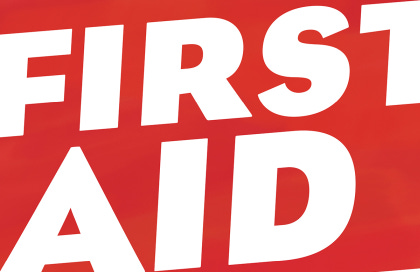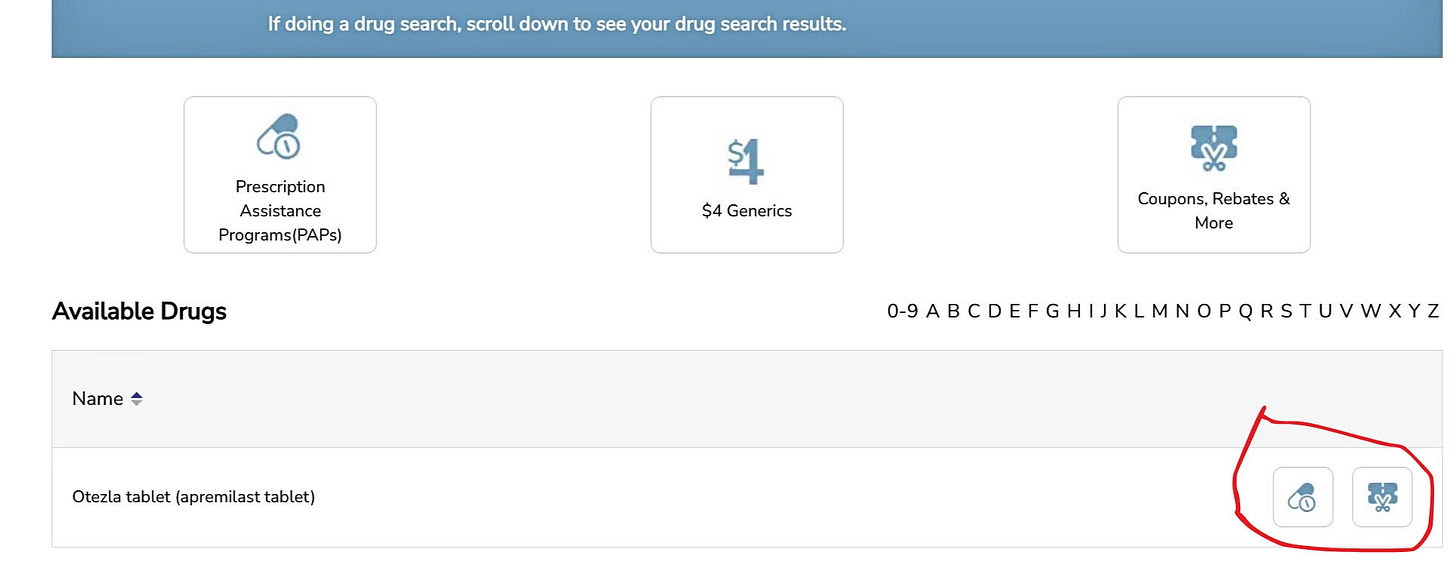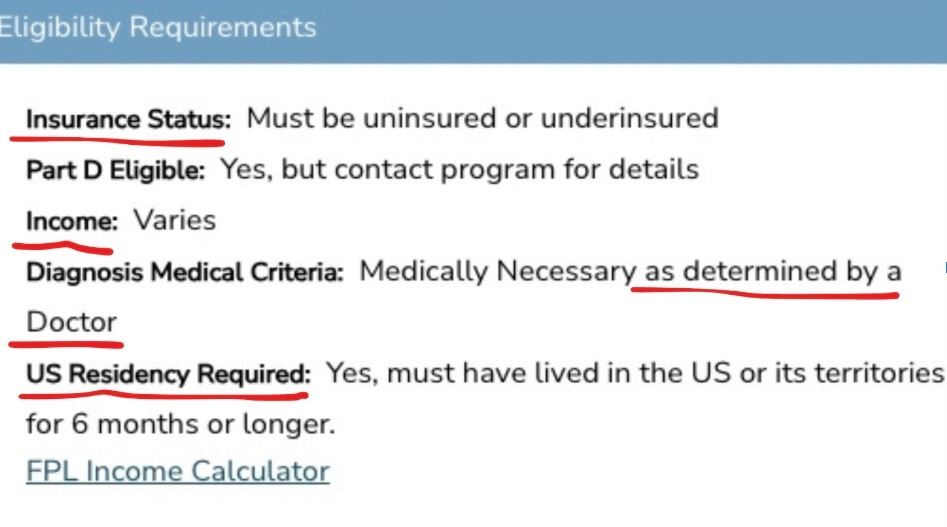An old school but worthy directory of prescription drug resources
Especially for need-based assistance programs
Hey there—
Welcome to the third installment in our series on dealing with the wild cost of prescription drugs.
We started by creating a price comparison tool inspired by one of our listeners — whose story we recounted on the podcast. Then, we zoomed out to suggest an order of operations for getting your meds for less.
This week, we’re looking at Patient Assistance Programs — PAPs for short — which are need-based programs offered by drugmakers and charitable organizations. If you qualify, you’ll get access to steeply discounted or free medication or other benefits.
We’ll get into what you need to know about PAPs — including important caveats — and why a website from 1997, NeedyMeds, can be a handy way to sort through them (with a bit of guidance).
What you need to know about PAPs
You’ve gotta apply, you’ve gotta qualify, and you may need some luck on top of that. And of course it all varies.
Applying: Can be simple, or more-involved. Sometimes you have to submit proof of (low) income, other times they take your word for it. Sometimes your provider has to sign off, sometimes no.
Qualifying: Mostly they look at income and family size — in other words, household income compared to a benchmark like 2 times the federal poverty line. Some only cover people with insurance, and others only help people without insurance.
Luck: Some programs have a limit on how much help they issue per year, and if your application arrives after they’ve hit that limit… better luck next time. Ugh.
Also this: Like other stuff we’ve looked at to deal with unaffordable drug prices, critics argue that PAPs are kind of a byproduct of how the pharma industry works — part of the problem.
But if you’re stuck using a really expensive drug for a chronic condition, let’s not ignore them.
What is NeedyMeds? And why use it to find PAPs?
In the 1990s, a family medicine doctor named Rich Sagall first heard of patient assistance programs from a friend who was a medical social worker. Together, the pair set out to make PAPs easier to find. Sagall taught himself HTML, and the site NeedyMeds was born.
Over the years, the site grew into a sort of super-directory for all kinds of medical resources — listings include a discount coupon program, as well as dog-walking for sick folks and disease-specific camps for kids.
Today, NeedyMeds still has somewhat of a 1997 vintage feel to it. And it’s no longer the only way to find PAPs online. You can easily Google your drug’s name + “assistance program.”
But here’s what sets NeedyMeds apart:
The site compiles the PAPs for each drug into one place, listing their phone numbers and websites, and sharing more information about eligibility requirements — which vary depending on the program — than we’ve seen elsewhere.
With a little guidance (below) we think that cuts a lot of steps out for you.
How to search NeedyMeds for PAPs
From the NeedyMeds' homepage, you’ll see a screen where you can “Search by Drug.”
Type in the name of your drug. Because some prescription drugs have multiple formulations, make sure to click on the one you need.
For instance, if you search the drug Abilify, you’ll get half a dozen choices. Do you take the injection? The tablets? Extended release? Check your prescription to make sure.
Once you’ve clicked on the correct formulation of your drug, the assistance options available will appear.
Let’s check out what comes up when searching the brand name drug Otezla, which treats psoriasis.
On NeedyMeds, PAPs are symbolized with a cute little pill and tablet illustration. The pill/tablet on the bottom right (circled above) takes you to a page listing all the programs available for this drug.
(That other icon takes you to coupons — worth checking out if you’re here. But there are lots of other ways to find coupons.)
For Otezla, two things come up: the Amgen Safety Net Foundation and the Patient Access Network Foundation (PAN).
The Amgen Safety Net Foundation offers Otezla for free to patients who qualify. PAN offers cash to patients dealing with a range of conditions facing high medical costs. (Both are charities backed — at least in part — by the pharmaceutical industry.)
Once you click on a program name for more information, scroll down to find the eligibility requirements.
This level of detail is what gives NeedyMeds a leg up over other ways of searching for PAPs — especially since you’ll see a big variety of processes and criteria for the programs offered by drugmakers.
For instance, let’s look at the Amgen one:
You can see here: These details help figure out if you might actually qualify for a given program.
You’ll also find a link to apply right on this NeedyMeds page, under a section called, helpfully, “Program Application and Forms.” And near the top, there’s a phone number for the program.
Heads up – NeedyMeds has some quirks
When you click on “Program Application and Forms” some of those links open up an application right there in your browser.
Pretty cool, but: you need to scroll past two pages of NeedyMeds stuff — including a page advertising their unrelated coupon program — before you hit the application itself.
And in some cases, we found the links in the PAP directory confusing — and at least one led to something that wasn’t a PAP at all, but rather an online pharmacy.
NeedyMeds told us they work to make sure resources are listed in the right place and to keep stuff up to date. And in fact, you can see when pages were last edited.
What if I don’t think I qualify?
…Or you might be an edge case?
Don’t give up, as co-founder Rich Sagall told us.
“If you find that you don't quite qualify but you're close,” he said, “apply anyway.”
And he says: Check back for updates periodically, because the eligibility requirements can change.
If you try out NeedyMeds — or have other experiences with PAPs that we should know about — we’d love to hear from you.
And if you haven’t checked out the other installments in our Prescription Drug Playbook series — two First Aid Kit newsletters (1, 2) and one podcast episode so far — we hope you’ll find them useful. There’s one more of each coming next week.
Till then,
— Emily Pisacreta, senior producer and FAK editor & Lauren Gould, intern










Get What’s Yours for Health Care
How to Get the Best Care at the Right Price
© Philip Moeller
(Simon & Schuster, 2021)
Excerpted with permission of the author.
Rich Sagall was a practicing family physician in Bangor, Maine, in the late 1990s when he became sensitized to the rising affordabil- ity problems his patients were having paying for their prescription drugs. “To be honest, I didn’t pay too much attention to whether people could afford the meds I was prescribing, and I think that was typical of most physicians.”
Sagall was alerted by a colleague to the growing number of patient assistance drug programs. The idea of gathering this information and making it available to patients occurred to him at the same time as he was teaching himself HTML, or hypertext markup language, the first set of tools that early Internet enthusiasts used to build websites.
Sagall and the colleague began building NeedyMeds. Its original focus was providing lower-income patients access to the patient as- sistance programs offered by pharmaceutical companies. After build- ing the site on evenings and weekends, Sagall got some development funding, set up NeedyMeds as a nonprofit, and began spending more and more time on what was no longer a hobby. He said goodbye to his partner—a medical social worker who had decided to move on to other activities—and later stopped practicing medicine to devote all of his time to the venture.
“I feel that with NeedyMeds I’m impacting thousands more peo- ple than I ever could in private medicine,” said Sagall, who later moved to Philadelphia and then Gloucester, Massachusetts, where he still lives.
. . .
Over the years, Rich Sagall has stuck to his original motivations. NeedyMeds has expanded and now provides consumer assistance programs that include:
• Pharmaceutical patient assistance programs, including online application forms (more than 340).
• Manufacturer coupons offering rebates, discounts or even free trials (more than 1,700 drugs).
• A national directory of $4 discount programs searchable by state, drug, and store.
• Drug formulation and dosage listings (more than 4,000).
• Diagnosis-specific assistance programs (more than 1,300).
• Free or low-cost clinics that charge on a sliding scale depending on patient incomes (more than 13,000).
• Organizations that help patients with application paperwork, either for free or a small fee (more than 800).
• Programs that bundle all available support and education programs for specific diseases (more than 50).
• Low-income government assistance programs at the state, county, and local levels (more than 700).